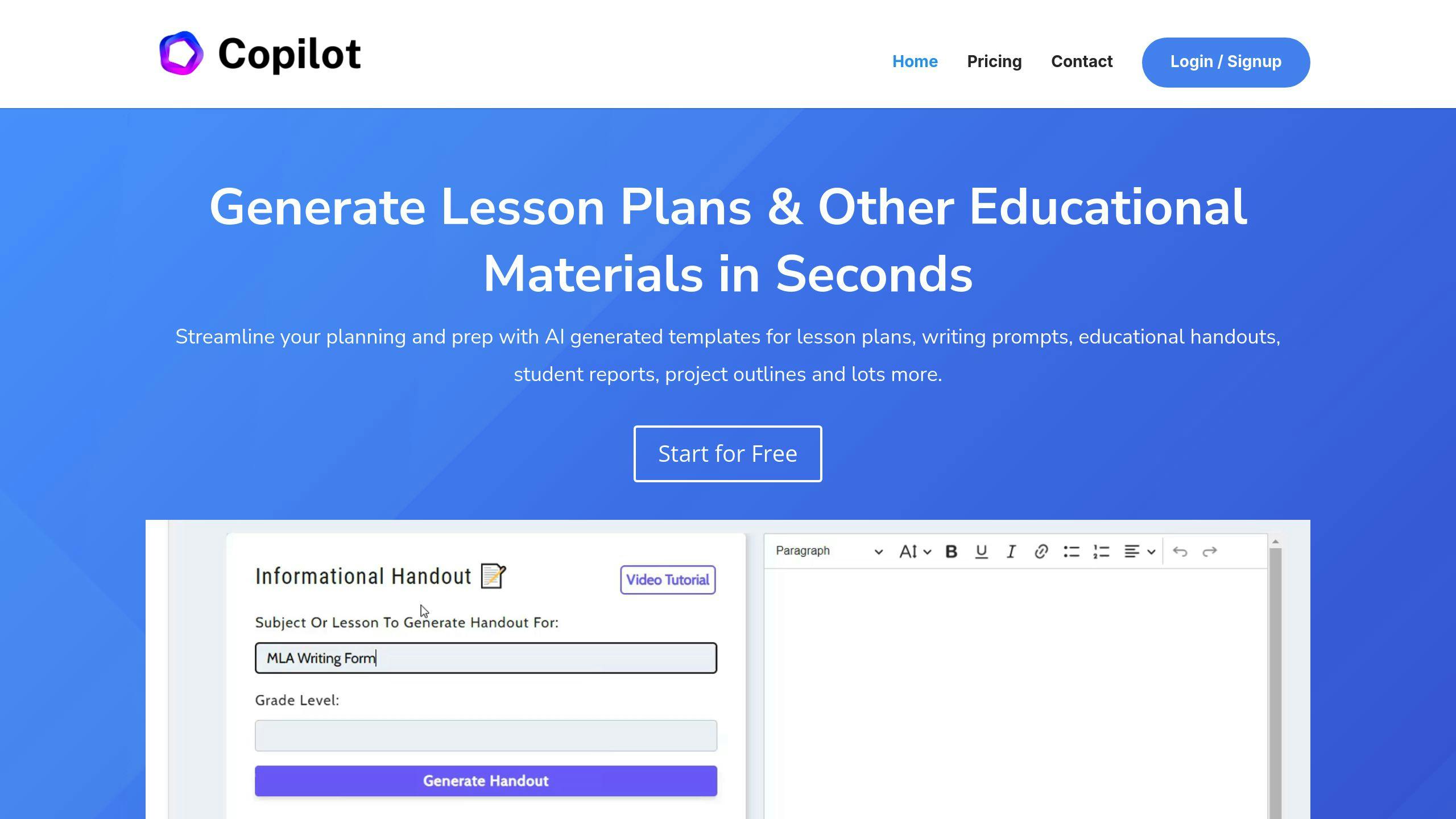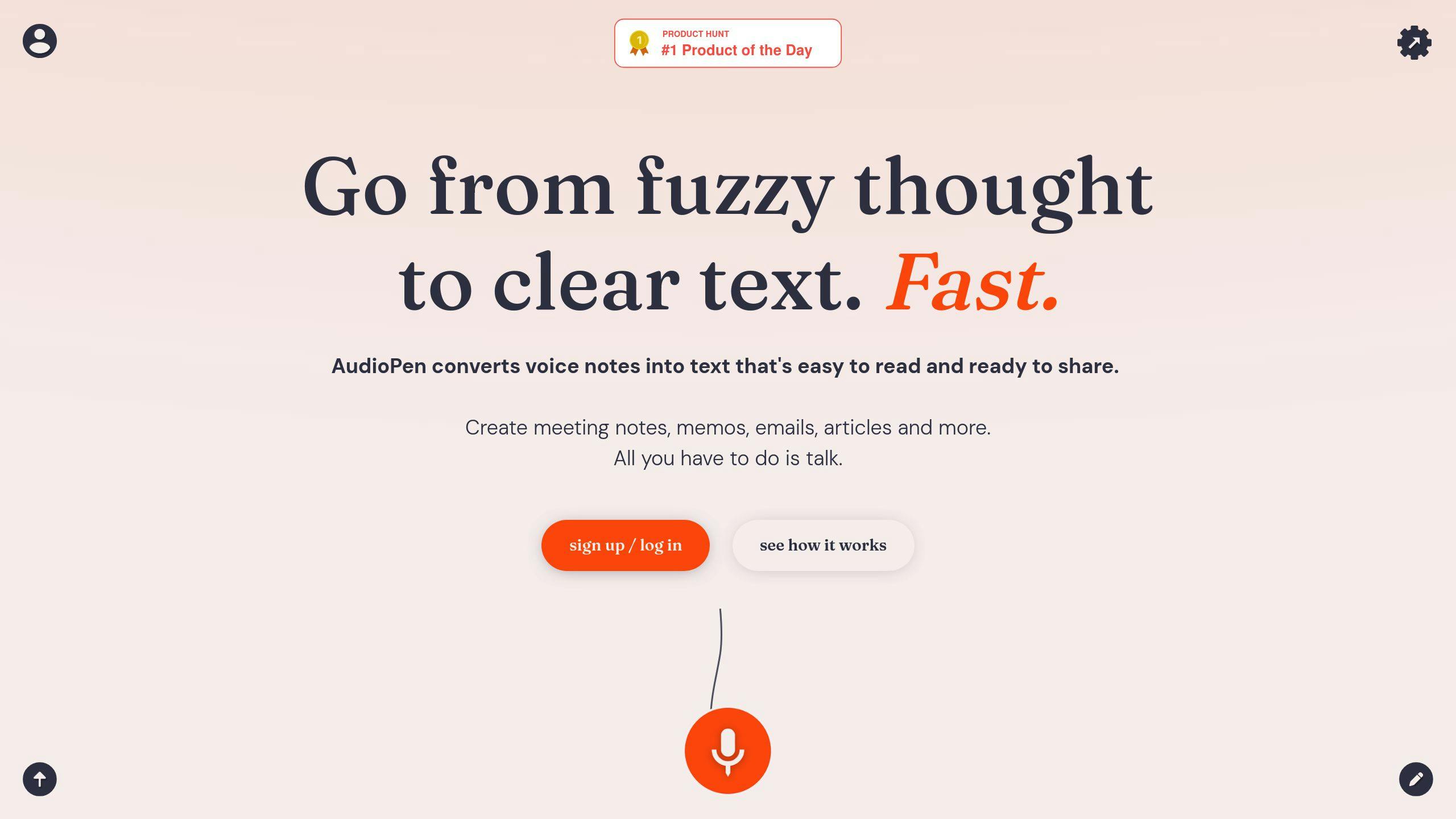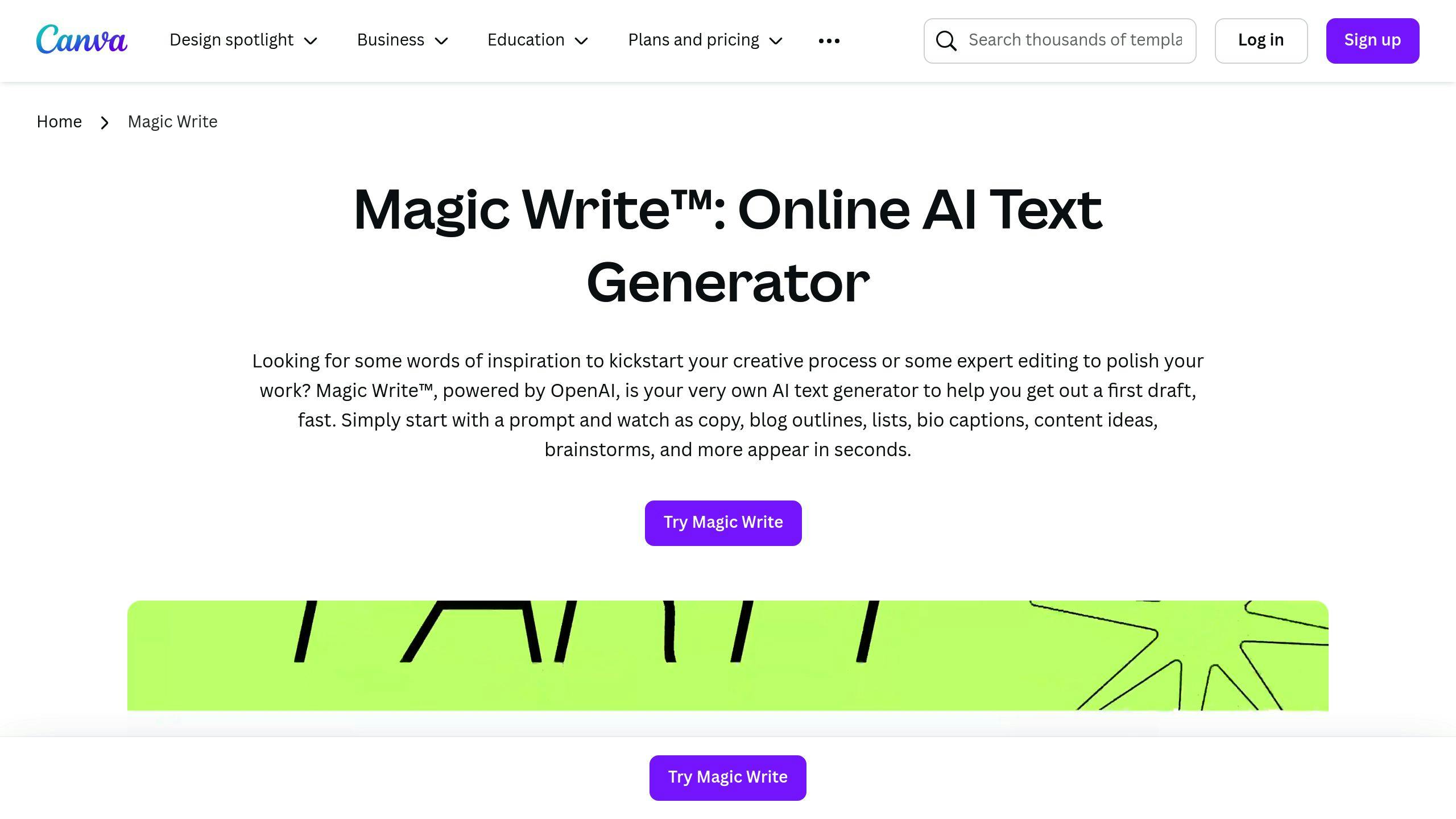Looking to boost student engagement and streamline your teaching? Here are 6 must-try EdTech tools for 2023:
- LessonBud - AI assistant for lesson planning and classroom management
- Education Copilot - Multilingual AI platform for creating educational materials
- Quizizz - Gamified quiz maker and homework platform
- AudioPen - Voice-to-text tool for quick note-taking and feedback
- Canva Magic Write - AI writing assistant for content creation
- ChatGPT - AI chatbot for generating lesson ideas and materials
Quick Comparison:
| Tool | Main Use | Key Benefit | Free Option? |
|---|---|---|---|
| LessonBud | Lesson planning | Saves time on prep work | No |
| Education Copilot | Content creation | Multilingual support | Free trial |
| Quizizz | Assessments | Makes quizzes fun | Yes |
| AudioPen | Note-taking | Fast transcription | Limited free plan |
| Canva Magic Write | Writing | Quick content drafts | Free trial |
| ChatGPT | Idea generation | Versatile applications | Yes |
These tools can help you create more engaging lessons, personalize learning, and cut down on administrative tasks. Start small by trying one tool that addresses your biggest pain point. Remember to balance tech use with traditional teaching methods for the best results.
How to Choose the Right Tools
Picking EdTech tools for your classroom doesn't have to be a headache. Let's break it down:
Define your needs. Before you get dazzled by new tech, ask yourself:
- What problem am I solving?
- How will this tool boost my teaching?
- Will my students actually benefit?
"These are all digital tools. Like building a house, you have many tools in your toolbox. What tools we use depends on the job we want to accomplish. But there's no substitute for quality teaching." - Valerie Truesdale, Chief Technology Officer at Charlotte-Mecklenburg Schools
Key factors to consider:
1. Usability
Is it easy for you and your students? If you're spending more time fixing than teaching, it's not the right fit.
2. Compatibility
Does it work with your existing tech? For example, does it play nice with your school's Learning Management System (LMS)?
3. Price
Is it within budget? Remember, pricier doesn't always mean better.
4. Data Security
How does it handle student data? This is a big deal in today's privacy-focused world.
5. Adaptability
Can it adjust to individual student needs? Look for tools offering personalized learning paths.
Use this table to evaluate potential tools:
| Factor | Questions to Ask |
|---|---|
| Usability | Easy to use? Steep learning curve? |
| Compatibility | Works with our LMS? Can we import existing content? |
| Price | Cost per user? Hidden fees? |
| Data Security | Complies with FERPA and COPPA? How's student data protected? |
| Adaptability | Adjusts difficulty based on performance? Offers varied activities? |
"Before you buy, work with the company to provide data that will help you answer your research question." - Barton Dassinger, Principal of the Cesár Chavez Multicultural Academic Center
This approach ensures you're not just buying a tool, but investing in a solution for your specific needs.
Practical steps:
- Start small: Treat your first try as a pilot. Get feedback and improve.
- Engage everyone: Ask teachers, students, and parents for input.
- Use free trials: Most EdTech companies offer them. Test thoroughly.
- Check support: Look for tools with solid customer support and training resources.
1. LessonBud

LessonBud is shaking things up as the first AI assistant made just for teachers. It's here to change how educators create lessons and handle classwork. The goal? Cut down on busywork so teachers can do what they do best: teach.
What makes LessonBud special? Let's break it down:
It whips up smart assignments in no time. Say goodbye to hours of brainstorming or hunting for ideas.
It makes student management a breeze. Tracking, grading, feedback - it's all simpler now.
It plays nice with how teachers already work. No need to flip your whole system upside down.
It won't break the bank. Good tools often cost an arm and a leg, but LessonBud aims to keep things affordable.
It's got your back on planning. From mapping out lessons to organizing classes and chatting with parents, LessonBud's got it covered.
But here's the real kicker: LessonBud makes classrooms run smoother and education more personal. It uses AI to help teachers create learning experiences that fit each student like a glove.
Picture this: A high school English teacher using LessonBud to:
"Generate writing prompts that match what we're studying right now."
"Create reading lists that work for different reading levels."
"Whip up quick quizzes to see if the lesson stuck."
LessonBud's AI can even look at how students are doing and suggest where they might need extra help. It's like having a super-smart teaching assistant.
But let's be clear: LessonBud isn't here to replace teachers. It's a tool to make their jobs easier and help students learn better. As we dive into this new tech, the focus should be on how it can work alongside teachers' skills.
LessonBud is an exciting step forward in bringing AI to the classroom. It's opening doors for educators at all levels to use this tech in ways that really count.
2. Education Copilot

Education Copilot is an AI-powered platform that's changing the game for teachers. It's like having a digital assistant that helps you plan lessons and manage your classroom more efficiently.
What makes Education Copilot special? For starters, it works in both English and Spanish. It's got over 10 different tools to help with everything from lesson planning to making handouts. And the best part? It can create educational materials in seconds.
Here's a quick look at some key features:
| Feature | What it does | Why it's useful |
|---|---|---|
| AI Templates | Creates lesson plans, prompts, handouts | Saves you time |
| Student Reports | Generates reports automatically | Makes assessments easier |
| Project Outlines | Helps plan projects | Structures assignments better |
| Unit Planner | Plans entire units | Helps with long-term planning |
Teachers are already loving Education Copilot. Over 200 educators are using it, and they're seeing big improvements in how they work. One teacher, Jennifer O, says:
"I'm already using copilot for lesson planning. It's brilliant for quick, casual lessons. Can't wait to see how it develops."
Education Copilot is super versatile. Need a quick writing prompt? It's got you covered. Want to plan a whole unit? It can do that too. It's great for:
1. Lesson Planning
It whips up structured lesson plans that fit your curriculum.
2. Making Content
It helps you create engaging PowerPoints and handouts.
3. Assessing Students
It makes custom reports and updates for students and parents.
Want to try it out? Education Copilot offers a free trial. You can test it out and see if it fits your teaching style before you buy.
Remember, Education Copilot is a tool to make your job easier, not to replace you. As the Education Copilot team says:
"We designed Education Copilot to save teachers time and effort. That way, they can focus on what really matters – their students."
3. Quizizz

Quizizz isn't just another EdTech tool. It's an online quiz maker and homework platform that's changing how teachers engage students and check their learning.
Here's the scoop on Quizizz:
- It's used in over 150 countries and more than half of U.S. schools
- It works on browsers and mobile devices (with iPhone and Android apps)
- It's free to start, with a $96/year plan for extra features
But here's the kicker: Quizizz makes assessments fun. As Luke Edwards, a freelance writer and editor, says:
"Quizizz makes quiz-based learning fun by adding gamification, making this a useful teaching tool."
Let's dive into what makes Quizizz special:
1. Huge quiz library
Teachers can pick from tons of pre-made quizzes. Use them as-is or tweak them to fit your class.
2. Real-time quizzes
Students compete against each other in live quizzes. It's like a game show in your classroom!
3. Instant feedback
Students see their scores right away. No more waiting for days to know how they did.
4. Detailed reports
Teachers get the full picture of how students performed, down to each question.
5. Different question types
From multiple-choice to open-ended, Quizizz has got you covered.
Here's a quick look at what you get with free vs. paid plans:
| Feature | Free Plan | Quizizz Super ($96/year) |
|---|---|---|
| Quiz creation | Some limits | No limits |
| Question types | Basic ones | Advanced (including audio/video) |
| No ads | Nope | Yep |
| Super library access | No | Yes |
| Custom feedback | Basic | Advanced |
Stephen Reid, an author who knows Quizizz, points out:
"With Quizizz, students complete the work at their own pace and therefore remain highly engaged throughout the quiz."
This self-paced approach is great for managing different learning speeds in your classroom. Fast finishers? Let them retry quizzes to boost their scores.
Quizizz has grown from a simple quiz game to a full-on learning platform. You can now use it for:
- Interactive lessons
- Quick reviews
- Self-paced homework
It's perfect for both in-class and remote learning.
Want to make the most of Quizizz? Try these tips:
- Start with the free version to get the hang of it
- Check out existing quizzes before making your own
- Mix up question types to keep things interesting
- Use the reports to spot where students need help
- Try both live quizzes and homework assignments
4. AudioPen

AudioPen is a voice-to-text tool that's changing the game for teachers. It turns spoken words into organized text, making note-taking and feedback a breeze.
Why are teachers loving AudioPen?
- It's FAST. Say goodbye to hours of typing.
- It's flexible. Use it for lesson plans, feedback, or quick ideas.
- It's smart. It uses OpenAI's Whisper API for top-notch transcription in multiple languages.
Here's what you get with AudioPen:
| Feature | Free Plan | Premium Plan |
|---|---|---|
| Recording time | 3 min/note | 15 min/note |
| Note storage | 10 notes | Unlimited |
| Summarization | No | Yes |
| Audio upload | No | Yes |
| Price | Free | $60/year or $120/lifetime |
Teachers are raving about it. Rob Lennon, an AI Whisperer, says:
"I used to manually summarize my transcribed brainstorming sessions. Took hours. AudioPen automates everything to the point where I am almost done with my article after talking about a topic for 10min. Magic."
How can you use AudioPen in your classroom?
- Record lectures and share transcripts with students.
- Give verbal feedback and send text versions.
- Brainstorm lesson ideas out loud and get organized notes.
- Capture key points from staff meetings without frantic writing.
Plus, AudioPen plays nice with Zapier, so you can easily export notes to other tools you use.
But remember: AudioPen is here to help, not replace good teaching. As Laurie Stark puts it:
"AudioPen is arguably the most important AI tool to be created besides ChatGPT. Game changing for my workflow."
Want to try it out? Start with the free plan. If you like what you see, the premium features can save you even more time and hassle.
sbb-itb-bb2be89
5. Canva Magic Write

Canva Magic Write is an AI-powered writing assistant that's changing the game for teachers. It's not just another tool - it's your content creation partner, built right into the Canva platform.
With Magic Write, you can create visuals AND content in one place. Here's what it can do for you:
- Flesh out lesson plans
- Generate writing prompts
- Craft social media posts
- Write email newsletters
And it's FAST. We're talking first drafts in seconds.
Now, let's talk price:
| Plan | Price | Magic Write Uses |
|---|---|---|
| Free Trial | $0 | 50 uses |
| Canva Pro | $12.99/month | 500 queries/month |
Pro tip: Start with the free trial. See if it fits your workflow before committing.
Susan Villemaire, an author who's used Magic Write, says:
"Magic Write can inspire improvement and help you to get out your first draft, fast."
But remember, it's not here to replace you. It's a tool to boost your skills. Use it to:
- Brainstorm project ideas
- Generate lesson outlines
- Create discussion topic lists
Try this: Type "10 video ideas for my science class" into Magic Write. Instant inspiration!
But let's be real. Magic Write isn't perfect. It's AI-powered, so you need to double-check its work. Review and edit the content it generates. You're still the expert in your classroom.
Is Canva Magic Write worth adding to your toolkit? If you want to save time on content creation and spark new ideas, it could be a game-changer. Just use it wisely - it's a helper, not a replacement for your expertise.
6. ChatGPT

ChatGPT is changing how teachers create content and plan lessons. This AI chat tool is becoming a go-to resource in classrooms, helping teachers work smarter and teach better.
Why is ChatGPT making such a splash in education? It's simple:
- It whips up lesson plans, quizzes, and writing prompts in no time
- It helps tailor instruction for different types of learners
- It acts like a virtual teaching assistant, answering questions and offering support
Let's look at how teachers are using ChatGPT to shake things up:
Lesson Planning: Now a Breeze
ChatGPT can create detailed lesson plans for any topic or grade level. Take Oregon English teacher Cherie Shields. She used ChatGPT to come up with 10 different project ideas for a high school sci-fi unit. One cool suggestion? Having students design an alien poster.
Teaching That Fits Everyone
ChatGPT helps teachers adjust materials for students with different needs. It can translate assignments or simplify content for language learners. This makes learning more accessible for everyone.
Whipping Up Assessments
Making quizzes is now a snap with ChatGPT. California English teacher Kim Lepre used it to create an article about the Salem witch trials for her seventh-graders. But she didn't stop there - she also got 10 different versions of a multiple-choice quiz to go with it.
Want to get the most out of ChatGPT? Try these tips:
- Be clear about what you want
- Know your goals
- Ask for different versions or tweaks
- Use it to spark ideas
Here's a prompt you can try:
"Create a fun science lesson for 2nd-graders about how plants need water and light to grow. Include a role-playing activity."
Just remember: ChatGPT is here to help you teach better, not to do your job for you. As Kim Lepre says:
"AI is already here. We can't run from it. Let's teach them how to leverage it."
Getting Started with Classroom Tech
Want to bring tech into your classroom? It's easier than you think. Here's how to get the ball rolling:
1. Figure Out What You Need
Before you buy anything, take a step back:
- What tech do you already have?
- What do your students really need?
- What are you trying to achieve in your teaching?
This quick check will help you pick tools that actually make a difference.
2. Take It Slow
Don't try to change everything overnight. Start small and build up. Here's a simple two-step approach:
1. Set Up a Digital Home Base
Kick things off with a platform like Google Classroom or Schoology. These tools help you keep all your lessons, handouts, and classwork in one place. It's like having a digital filing cabinet that students and parents can access anytime.
2. Spice Up Your Lessons
Once you're comfortable with the basics, try creating more engaging content. Tools like Canva Magic Write can help you whip up eye-catching visuals without a design degree.
3. Train Everyone
Tech only works if people know how to use it. So, make time for learning:
- Get to know your tools inside and out
- Show your students the ropes (and why it matters)
- Give parents some tips to help out at home
4. Set Some Ground Rules
Make it clear when and how to use devices in class. Here's a simple guide:
| When | Device Use | What's Expected |
|---|---|---|
| Group talks | Off | Listen and speak up |
| Research time | On | Focus on finding info |
| Solo work | Your choice | Work quietly on your own |
Put this up on the wall so everyone's on the same page.
5. Mix It Up
Tech lets you shake things up in the classroom. Try:
- Group tables for team projects
- Quiet corners for focused work
- A tech zone for charging and quick fixes
6. Keep an Eye on Things
Check in regularly to see how well the tech is working. Try this:
- Plan how you'll use tech
- Give it a go in class
- See what worked (and what didn't)
- Make changes based on what you learned
This helps you keep improving how you use tech in class.
7. Show Why It Matters
Help students see why tech skills are important. As Miss Tech Queen, a teacher, says:
"Students always learn more when they understand why they are learning it."
Talk about tech heroes or how these skills apply to different jobs.
8. Let Creativity Loose
Encourage students to use tech in creative ways:
- Make digital comics to explain ideas
- Create videos for book reports or science experiments
- Use data tools in math and science projects
What's Next in Education Tech
The education tech landscape is changing fast. Here's what's coming:
AI-Powered Personalization
AI is set to shake up how we tailor education:
- AI will create custom learning paths for each student
- Virtual tutors will offer 24/7 support, matching each student's learning style
Immersive Learning Experiences
By 2025, VR and AR will be big in EdTech:
| Tech | Use | Why It's Cool |
|---|---|---|
| VR | History lessons | "Experience" historical events |
| AR | Science experiments | Add digital info to real objects |
| Mixed Reality | Language practice | Immersive conversation environments |
These tools will make learning more fun and help students grasp tough concepts.
Biometric-Enhanced Learning
Biometrics will change how classrooms work:
"This tech will help software understand kids' physical and emotional state while learning." - Nick Grantham, FractusLearning
Imagine software that spots when a student is stuck and tweaks the lesson or pings the teacher. That's game-changing for personalized teaching.
Cloud-Based Collaboration
Cloud learning platforms are taking off:
- Schools save money
- Students get better access to resources
- Everyone can work together more easily
Schools using these platforms will run smoother and offer more flexible learning.
Data-Driven Decision Making
Smart analytics will help educators make better choices:
1. AI tools will track student progress in detail, showing teachers where to focus.
2. Schools will spot struggling students early and step in to help.
3. Data will help fine-tune courses and teaching methods.
Career-Focused Learning
Career Technical Education (CTE) is making a comeback:
- 75%+ of CTE students go on to higher education
- CTE students graduate at a 10% higher rate
This trend shows a push to prep students for real jobs while keeping them engaged.
Nano Learning
Bite-sized lessons are on the rise:
- Quick, focused learning
- Perfect for learning on your phone
- Helps people keep learning throughout life
This style fits modern attention spans and busy lives, making education more accessible.
The future of EdTech is exciting. For teachers, staying up-to-date and flexible will be key to using these new tools effectively in class.
Wrap-Up
Let's recap the top EdTech tools for teachers and how to use them in your classroom:
Key Takeaways
- AI tools like ChatGPT and Education Copilot are changing the game for lesson planning and personalized learning.
- Interactive platforms like Quizizz make assessments more fun and boost student engagement.
- Tools like AudioPen and Canva Magic Write help cut down on admin work, giving you more teaching time.
- AI-powered tools can create tailored learning experiences for different student needs.
Next Steps
Here's how to start using these tools in your classroom:
1. Start small
Pick one tool that solves a specific problem. Maybe use Quizizz to make your quizzes more engaging. Get comfortable with it, then add more tools later.
2. Match tools to your goals
| Tool | What it's good for |
|---|---|
| LessonBud | Custom lesson plans |
| Quizizz | Fun quizzes |
| ChatGPT | Writing prompts |
Choose tools that fit your teaching goals and curriculum.
3. Learn the tools
Take time to really learn how to use these tools. As Hillary Gale Decker, a High School English Teacher, puts it:
"The key takeaway is that by focusing on a few team members at a time, eventually, the culture shifts."
Maybe pick a few "EdTech champions" among your colleagues to help others learn.
4. Get students involved
Let students try out the tools and tell you what they think. It helps you improve and gets them ready for a tech-heavy future.
5. Keep an eye on results
Regularly check how these tools are affecting student learning and engagement. Use this info to tweak your approach.
6. Stay in the loop
EdTech changes fast. Keep up by going to workshops, joining online groups, and doing professional development.
Remember: tech should make your teaching better, not replace it. As you bring in these tools, keep a good mix of tech and traditional teaching methods.
FAQs
What is the best AI to use for teachers?
There's no one-size-fits-all answer, but Canva is a standout AI tool for educators. Here's why:
Canva is versatile, user-friendly, and packed with features. It's great for creating visual aids, lesson plans, and interactive presentations. Even if you're not tech-savvy, you'll find it easy to use.
The best part? Canva is free. That's a big plus for budget-conscious teachers.
But what about lesson planning? Check out Suraasa's Lesson Plan Generator. It creates custom plans based on grade, subject, and curriculum. It's a real time-saver that still meets educational standards.
What is the best free AI tool for teachers?
Canva takes the crown here. Let's compare it to ChatGPT:
| Feature | Canva | ChatGPT |
|---|---|---|
| Main Use | Visual content | Text generation |
| Ease of Use | Super easy | Bit of a learning curve |
| Customization | Tons of visual options | Flexible text prompts |
| What You Get | Eye-catching visuals | Written content and ideas |
| Works With Other Tools | Yep, no problem | Needs more setup |
Canva shines when it comes to creating engaging classroom materials. But remember, the "best" tool depends on what you need and how you teach.
Both have their strengths. Canva is your go-to for visuals, while ChatGPT excels at generating text and ideas. Pick the one that fits your teaching style best.


